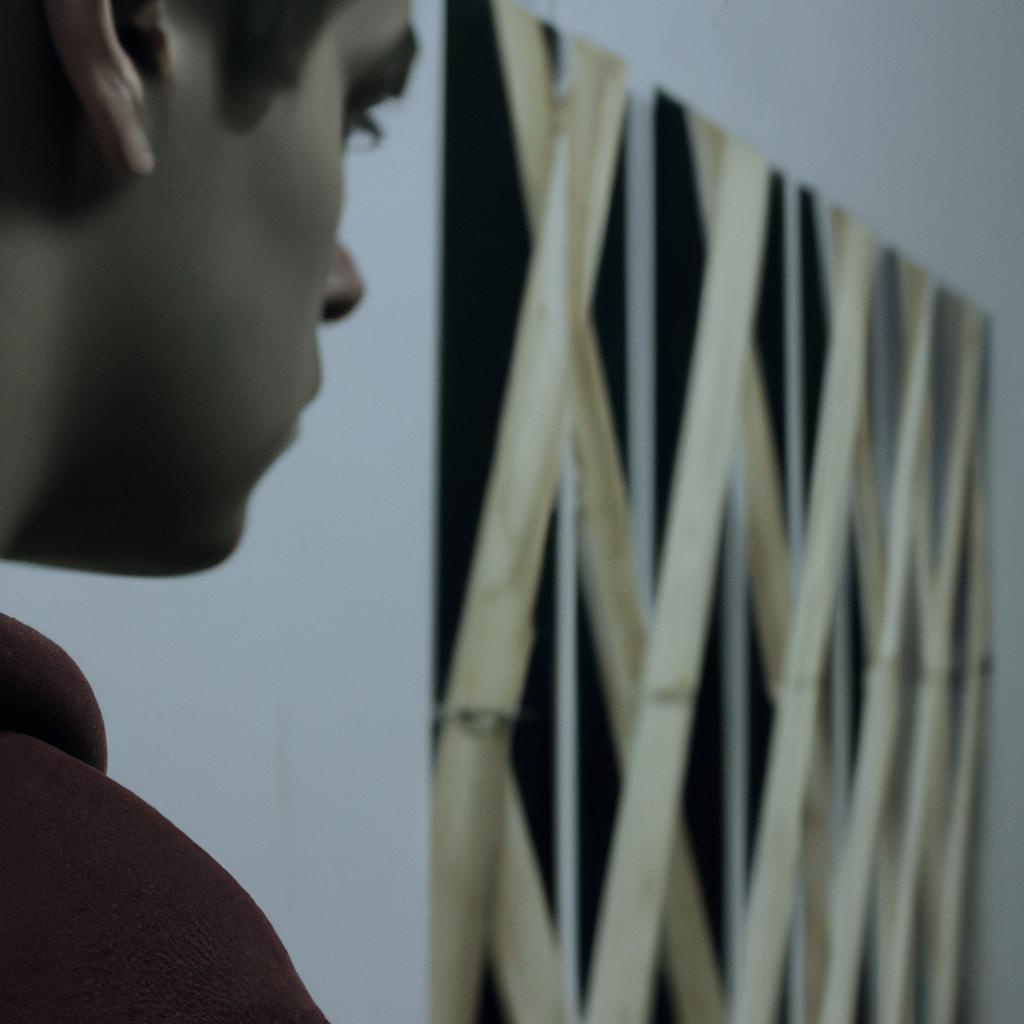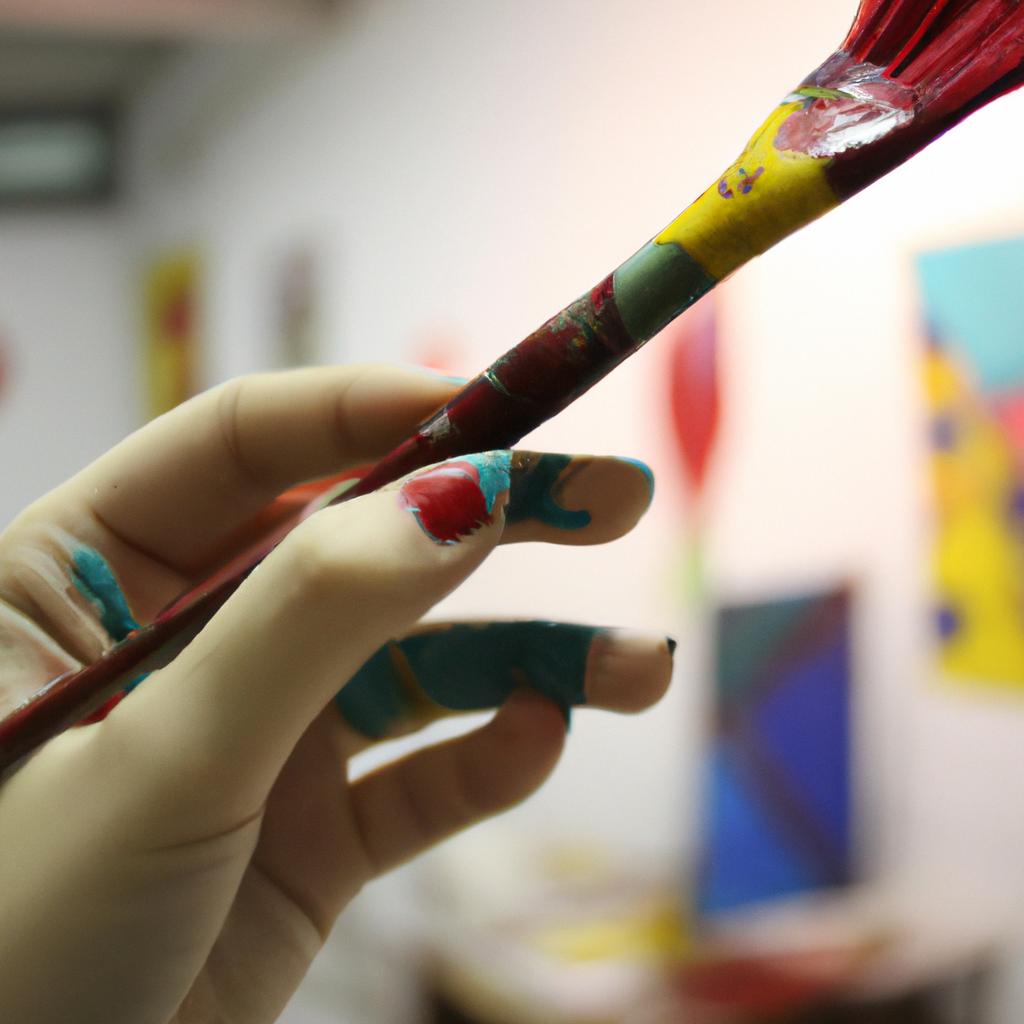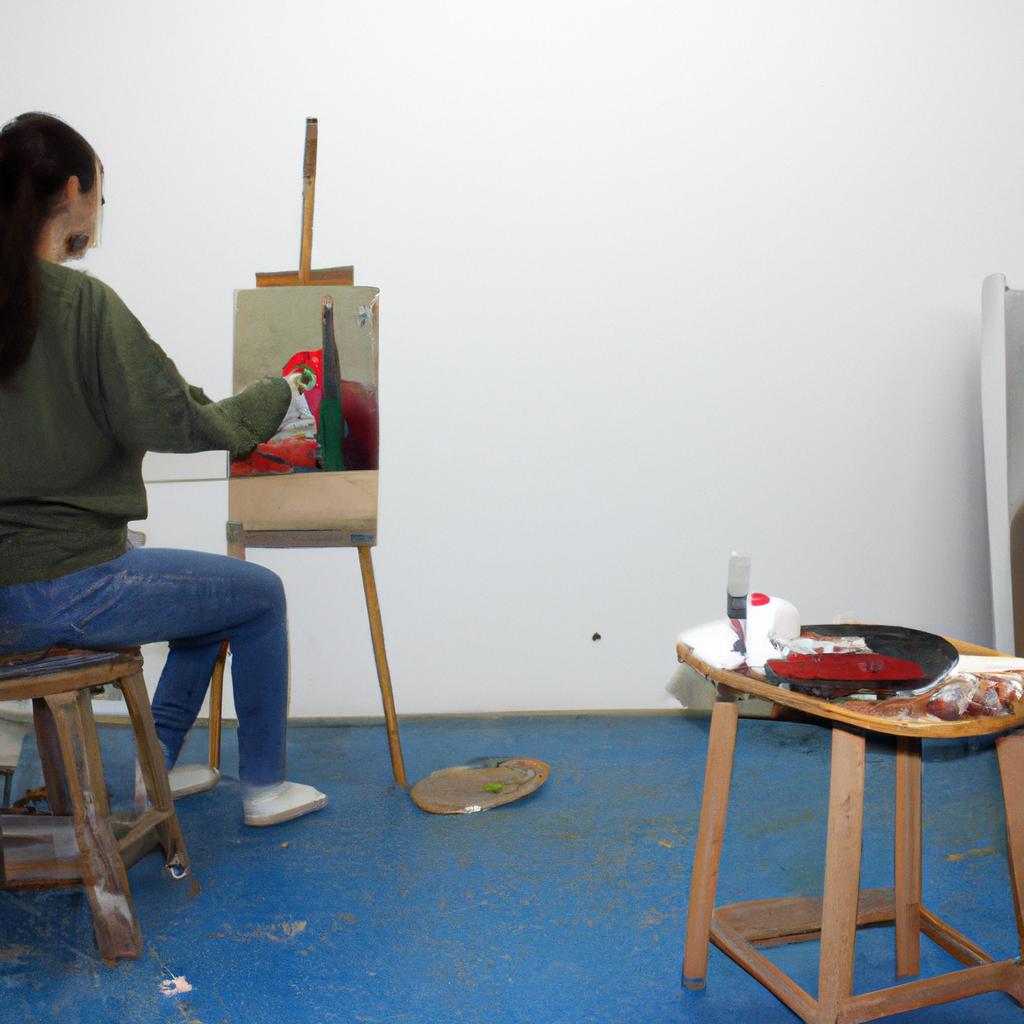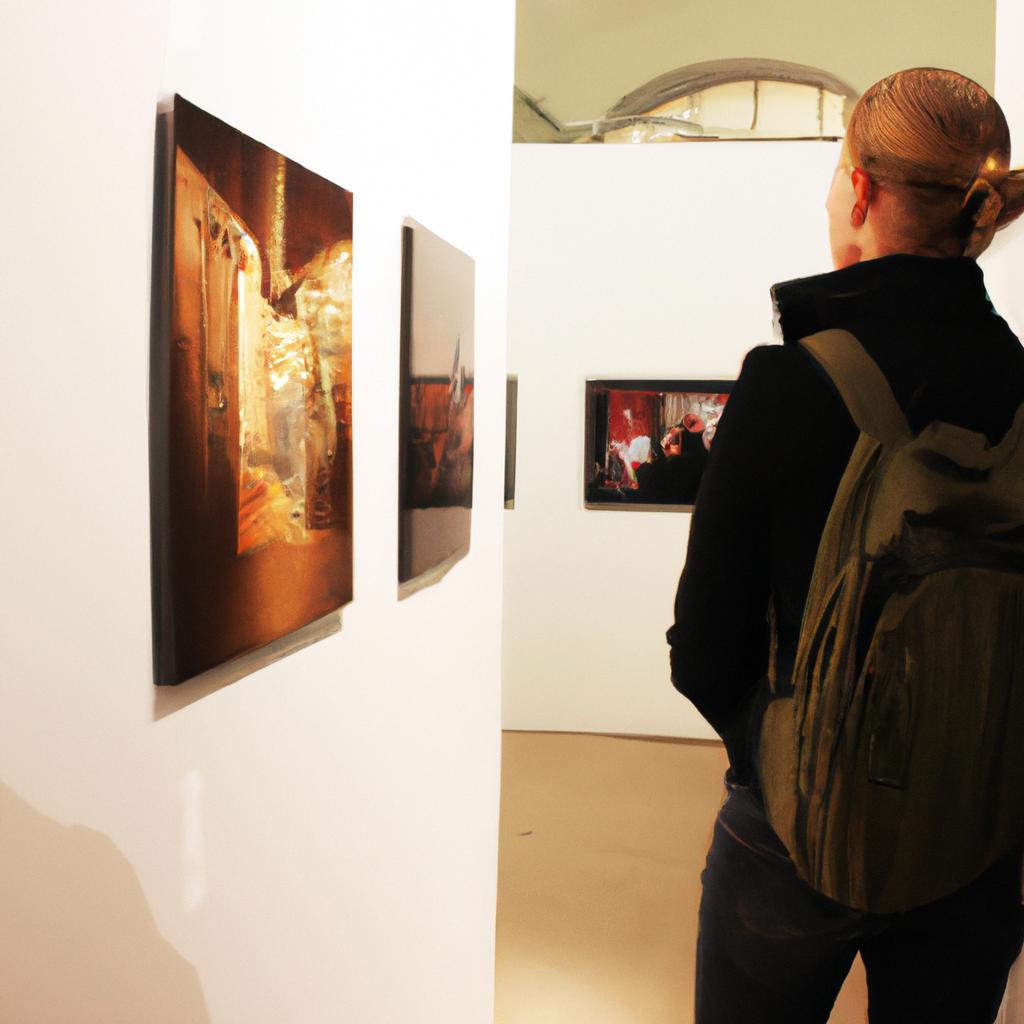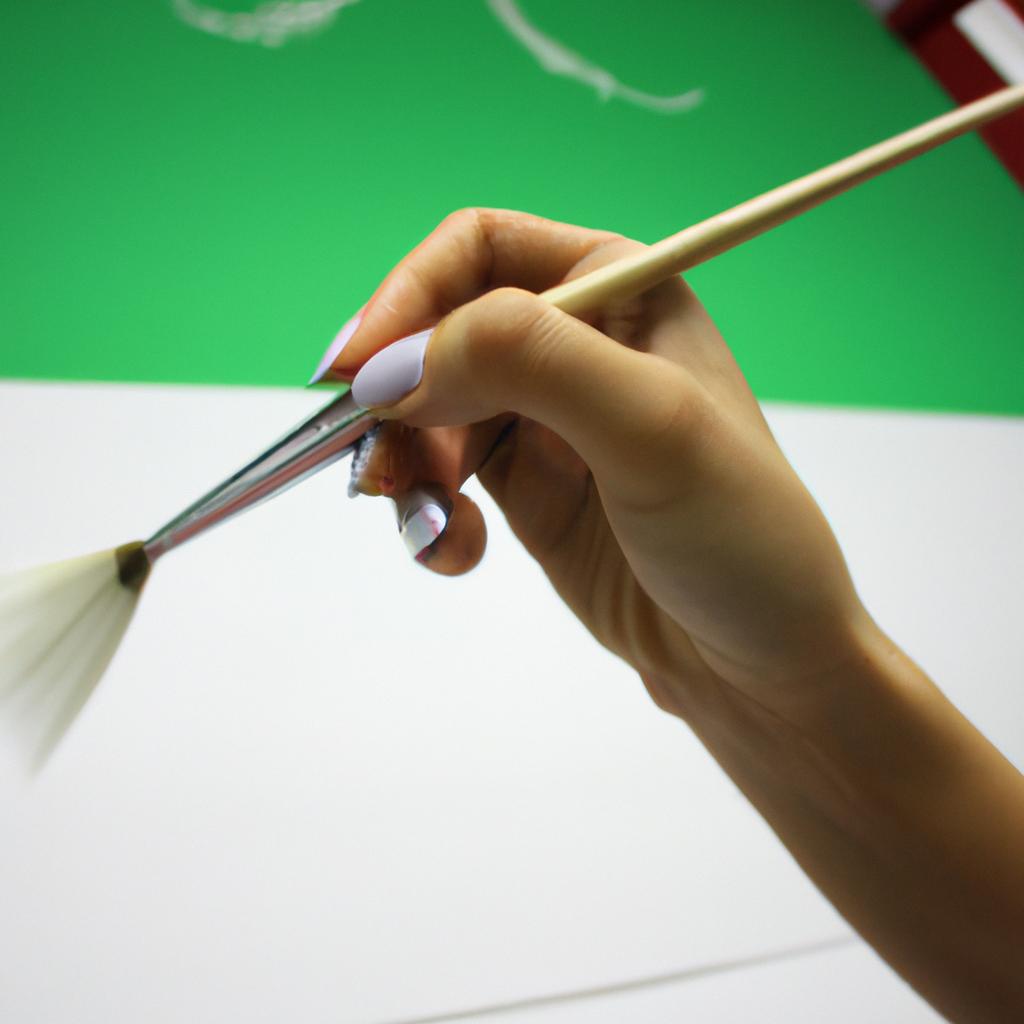Artistic Commissions: Visual Arts Loaned Inspirations

Artistic commissions have long been an integral part of the visual arts world, serving as a means for artists to create works of art inspired by specific themes or subjects. These commissions not only provide artists with opportunities to showcase their creativity and skill, but also offer patrons and collectors the chance to support and engage with contemporary artistic practices. This article explores the concept of artistic commissions in the context of visual arts, highlighting their significance and impact within the creative realm.
For instance, consider a hypothetical scenario where a renowned museum approaches a talented artist to commission a series of paintings based on the theme of environmental conservation. The artist is tasked with creating artworks that convey the beauty of nature while raising awareness about pressing ecological issues. Through this commission, both the museum and the artist collaborate to promote social consciousness through art. Such instances exemplify how artistic commissions can serve as platforms for fostering dialogue between artists and institutions, allowing them to address pertinent societal concerns through visual expressions.
This article delves deeper into understanding the dynamics behind artistic commissions in visual arts by examining various aspects such as historical precedents, economic implications, and curatorial considerations. By analyzing case studies from different periods and regions, we will explore how these commissions function as catalysts for innovation within artistic practice. Additionally, we will also explore the role of patrons and collectors in commissioning artwork, discussing their motivations and the impact they have on shaping artistic production. Furthermore, we will delve into the collaborative nature of commissions, examining how artists work closely with institutions or individuals to ensure that their creative vision aligns with the intended message or theme.
In addition to exploring the overarching significance of artistic commissions, this article will also address the practical aspects involved. We will discuss how artists negotiate fees and contracts for commissioned works, as well as the challenges they may face in meeting specific requirements while maintaining their unique artistic voice. Moreover, we will touch upon issues such as copyright and ownership rights that arise when artworks are commissioned.
Ultimately, this article aims to shed light on the multifaceted nature of artistic commissions in visual arts. By highlighting their historical importance, economic implications, curatorial considerations, and practical aspects, readers will gain a comprehensive understanding of how these commissions contribute to the vibrant landscape of contemporary art. Whether you are an artist looking to navigate commission opportunities or a patron interested in supporting artists through commissioned works, this article will provide valuable insights into this fascinating aspect of the art world.
Purpose of Artistic Commissions
Artistic commissions serve as a vital means for promoting creativity and fostering the development of visual arts. By providing artists with opportunities to create original works, these commissions contribute to the growth of artistic expression and cultural enrichment. One example that illustrates the significance of such commissions is the case of renowned artist Maria Lopez, who was commissioned by a local gallery to create an immersive installation exploring themes of identity and belonging. This project not only allowed Lopez to showcase her talent but also provided viewers with a thought-provoking experience.
- Supporting emerging artists: Commissions offer emerging talents valuable exposure and recognition within the art community.
- Enriching public spaces: Commissioned artworks can transform public spaces into vibrant cultural hubs, enhancing their aesthetic appeal and creating engaging environments for all.
- Preserving heritage: Through commissions, traditional art forms are revitalized and preserved, ensuring their relevance in modern society.
- Engaging communities: Artists collaborating on commission projects often involve members of local communities, fostering inclusivity and encouraging dialogue.
Moreover, a table can be used to highlight key aspects related to artistic commissions:
| Key Aspects | Benefits | Examples |
|---|---|---|
| Financial support | Allows artists to focus solely on their creative process | Grant funding |
| Exhibition opportunities | Provides exposure through exhibitions or events | Solo exhibition at prestigious museum |
| Collaboration | Encourages collaboration between artists from different disciplines | Sculptor working alongside a painter |
| Public recognition | Increases visibility among art collectors, galleries, and critics | Winning an award for commissioned artwork |
In summary, artistic commissions have various purposes that extend beyond simply supporting individual artists. They facilitate creativity while enriching public spaces and preserving cultural heritage. Recognizing the significance of commissions in promoting artistic growth, it is essential to understand the selection process for artists involved.
Selection Process for Artists
Transitioning from the previous section on the purpose of artistic commissions, we now turn our attention to the selection process for artists. In order to ensure that the loaned inspirations are brought to life by talented individuals who can effectively capture their essence, a meticulous and rigorous procedure is followed.
To illustrate this process, let us consider a hypothetical scenario where an art gallery decides to commission an artist for a new exhibition centered around urban landscapes. The first step in selecting an artist entails conducting extensive research and reviewing portfolios of potential candidates. This initial evaluation allows the gallery curators to gauge the artists’ styles, techniques, and overall suitability for the project.
Once a shortlist of artists has been compiled, further assessments take place through interviews or discussions with each candidate. These interactions provide valuable insights into their creative vision, ability to meet deadlines, and capacity for collaboration. It also enables the curators to assess how well an artist’s previous works align with the theme of urban landscapes.
In addition to these subjective evaluations, objective criteria play a key role in determining which artist ultimately secures the commission. Factors such as professional experience, technical proficiency, and demonstrated success in similar projects carry significant weight during the decision-making process. Moreover, considerations may include an assessment of an artist’s reputation within the art community and their ability to handle large-scale installations or exhibitions.
The selection process outlined above ensures that only highly qualified artists are chosen for commissions. By combining both qualitative assessments and quantitative measures, galleries aim to mitigate risks associated with mismatched collaborations while maximizing artistic quality and impact.
Next, we delve into different types of artistic commissions wherein specific contexts shape the nature of these creative endeavors. Understanding these variations will shed light on how commissioned artworks cater to diverse needs across various fields without compromising their aesthetic integrity or conceptual depth
Types of Artistic Commissions
The selection process for artists in the context of artistic commissions is a crucial step that ensures the loaned inspirations align with the vision and goals of the commissioning entity. By carefully curating a diverse pool of talented artists, organizations can guarantee a high standard of quality and creativity in their commissioned artworks.
To illustrate this process, let’s consider an example where an art gallery plans to commission five artists to create visual pieces inspired by historical events. The gallery initiates an open call for submissions, inviting artists from various backgrounds and styles to submit their portfolios and proposals. This initial stage aims to cast a wide net and encourage participation from both established and emerging talents.
Once the submission deadline has passed, the gallery’s selection committee meticulously reviews each application based on predetermined criteria such as artistic merit, relevance to the theme, technical proficiency, and potential impact on viewers. Through careful deliberation, they shortlist ten candidates whose submissions stood out among the rest. These finalists are then invited for interviews or presentations where they have the opportunity to further showcase their ideas and engage in discussions about their proposed artwork.
After these interviews, the selection committee thoroughly evaluates all aspects of each candidate’s submission – including concept development, feasibility within budget constraints, and compatibility with other commissioned works – before making final decisions. From this rigorous evaluation process emerges a group of accomplished artists who will be awarded contracts to bring their unique perspectives to life through visual arts.
This meticulous approach ensures that only exceptional artworks make it into exhibitions or collections associated with artistic commissions. It guarantees diversity in style, medium, and interpretation while maintaining coherence within overarching themes or narratives. Ultimately, this thorough selection process acts as a catalyst for showcasing outstanding talent while fostering innovation within the realm of visual arts.
Benefits of Artistic Commissions
Artistic Commissions: Visual Arts Loaned Inspirations
Types of Artistic Commissions are varied and diverse, catering to the unique needs and preferences of both artists and patrons. Building upon this understanding, let us explore some specific examples that exemplify the rich possibilities within artistic commissions.
Consider a hypothetical scenario where an art collector is interested in commissioning a portrait of their family. They approach a talented painter who specializes in realistic portraiture. Through discussions with the artist, the collector shares details about their family’s personality traits, hobbies, and interests. The artist carefully considers these aspects while creating the artwork, resulting in a captivating portrait that not only captures physical likeness but also reflects the essence of each family member.
To further illustrate the potential impact of artistic commissions, here is a bullet point list highlighting key benefits:
- Uniqueness: Commissioned artworks provide one-of-a-kind pieces tailored specifically for individuals or organizations.
- Collaboration: Patrons have the opportunity to actively engage with artists throughout the creative process.
- Personalization: Artists can incorporate personal stories, memories, or symbols into commissioned works.
- Support for Artists: Commissions offer financial support to artists by providing opportunities for income generation.
Additionally, we can use a table format to showcase various types of artistic commissions:
| Type | Description |
|---|---|
| Portrait | Paintings or photographs capturing people’s likenesses |
| Mural | Large-scale paintings created on walls or ceilings |
| Sculpture | Three-dimensional artworks made from materials such as clay, metal, or wood |
| Illustration | Visual representations used in books, magazines, advertisements, or digital media |
Through artistic commissions like these mentioned above and many others beyond them, collaboration between artists and patrons fosters creativity while fulfilling individual desires for meaningful and personalized art experiences.
Transitioning seamlessly into the subsequent section about “Promoting Collaboration in the Art Community,” we can see how artistic commissions not only benefit individuals but also contribute to a more interconnected and vibrant art community.
Promoting Collaboration in the Art Community
Benefits of Artistic Commissions: Visual Arts Loaned Inspirations
Transitioning from the previous section, where we explored the various benefits of artistic commissions, let us now delve into how these commissions promote collaboration in the art community. To illustrate this point, consider the following hypothetical scenario:
Imagine an artist named Sarah who specializes in abstract painting. Sarah is approached by a local museum to create a commissioned piece for their upcoming exhibition on contemporary art. The museum provides Sarah with specific guidelines and themes to incorporate into her artwork, aiming to align it with the overall theme of the exhibition.
This collaborative process between artists and institutions or clients fosters creativity while encouraging new perspectives within the art world. It allows artists to expand their horizons beyond personal preferences and explore different mediums, styles, or subject matters that they may not have otherwise considered.
To further understand how artistic commissions promote collaboration, let us examine some key aspects:
-
Diverse Perspectives: Collaborative commissions often involve multiple stakeholders such as curators, collectors, or even other artists. This diversity fuels creative discussions and encourages artists to think outside the box.
-
Shared Vision: Through effective communication and brainstorming sessions, both parties involved can establish a common vision for the commissioned artwork. This shared vision ensures that all contributors are aligned towards creating a cohesive final product.
-
Professional Growth: Working on commissioned projects challenges artists to push their boundaries and experiment with new techniques or concepts. This growth expands their skill set and enhances their professional development.
-
Community Engagement: Commissioned artworks frequently find themselves displayed in public spaces or museums accessible to broader audiences. This exposure not only promotes engagement but also bridges gaps between communities through shared appreciation for art.
The table below showcases how artistic commissions foster collaboration among diverse entities in the art community:
| Entities Involved | Roles Played | Contributions |
|---|---|---|
| Artists | Creators | Artistic expertise |
| Curators | Facilitators | Conceptual guidance |
| Institutions | Supporters | Resources and exposure |
| Collectors | Patrons | Financial support |
By promoting collaboration, artistic commissions facilitate a mutual exchange of ideas, skills, and resources within the art community. This collective effort nurtures creativity, innovation, and deeper connections among artists, institutions, curators, collectors, and viewers alike.
Transitioning into the next section on “Success Stories of Artistic Commissions,” we will now explore specific cases where artistic collaborations have yielded remarkable outcomes that continue to inspire and influence the ever-evolving world of visual arts.
Success Stories of Artistic Commissions
In recent years, there has been a growing emphasis on promoting collaboration within the art community. This shift towards fostering partnerships and cooperative ventures has opened up new opportunities for artists to expand their creative horizons and reach wider audiences. One example that showcases the power of collaborative artistic commissions is the case study of an established painter teaming up with a renowned musician to create a unique multimedia experience.
This collaboration began when the painter was commissioned by a music festival to create artwork inspired by the performances taking place during the event. Instead of working independently, they decided to approach this project as a joint endeavor, seeking inspiration from each other’s work throughout the creative process. The result was a series of paintings that captured not only the visual essence of the performances but also incorporated elements of sound and rhythm into their composition.
The success of this collaborative commission highlights several benefits that can be derived from promoting collaboration within the art community:
- Enhanced creativity: By bringing together different artistic disciplines, collaborations allow for cross-pollination of ideas and techniques, leading to fresh and innovative creations.
- Expanded audience engagement: Collaborative projects often attract diverse audiences who may have varied interests in different art forms, thereby increasing exposure for all participants involved.
- Mutual learning and growth: Artists collaborating with others gain valuable insights and knowledge from their partners, helping them develop new skills or perspectives that can enrich their own practice.
- Strengthened sense of community: Working together fosters a sense of camaraderie among artists, encouraging support and cooperation within the art community.
To further illustrate these points, consider the following table showcasing some notable examples where collaborations between artists from different mediums resulted in remarkable artworks:
| Collaborators | Mediums | Outcome |
|---|---|---|
| Visual artist + Poet | Painting | A collection combining imagery with poetic verses |
| Sculptor + Choreographer | Sculpture | Dynamic sculptures inspired by dance movements |
| Photographer + Writer | Photography | Photographic series accompanied by short stories |
| Filmmaker + Composer | Film | A cinematic experience with original score |
In conclusion, promoting collaboration within the art community has proven to be a catalyst for creativity and growth. Through joint artistic commissions, artists have the opportunity to explore new avenues of expression, engage wider audiences, learn from one another, and foster a sense of unity within their creative circles. This collaborative approach not only benefits individual artists but also contributes to the overall vibrancy and diversity of the art world.
